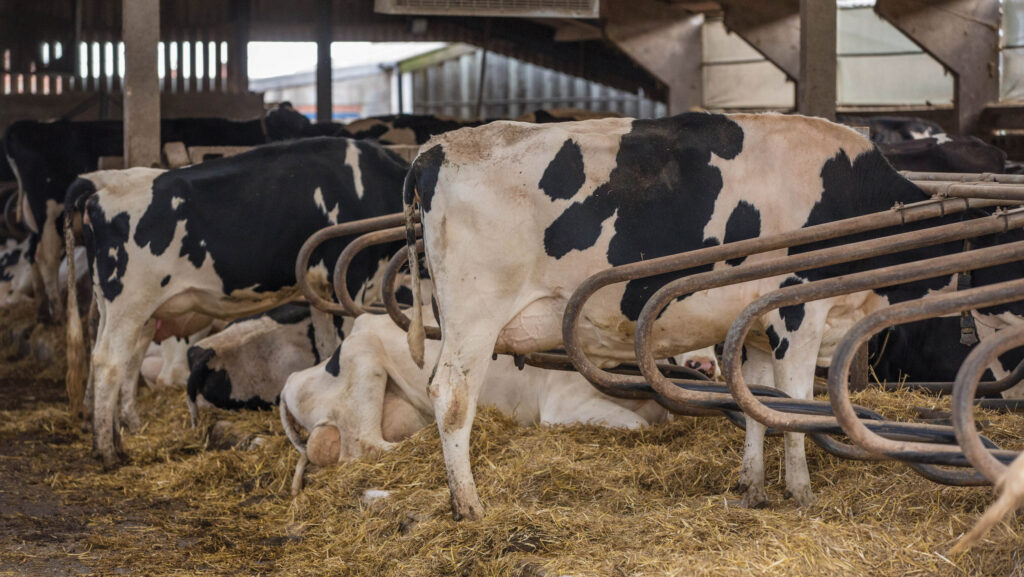How hock and neck sores can limit milk yield potential
 © Tim Scrivener
© Tim Scrivener Hock lesions and neck rubs could be depriving high-yielding cows of their ability to achieve their full genetic potential.
An additional two lactations will also be forfeited, according to Cow Signals trainer Piers Badnell.
See also: A guide to giving cows grazing-level comfort indoors
He says herds that have invested in top-performing bloodlines need to look at what is limiting their success, if they are failing to produce 12,000-14,000 litres in a lactation.
And rather than looking for a major disease or a ration factor, he suggests it could instead be some cow comfort issues.
There are six things that managers need to get right for a cow: feed, water, light, air, rest and space.
In a cow’s perfect day, she lies down for 14 hours (ruminating for 10 of them), says Piers.
“She spends six hours eating and drinking, two socialising and two hours milking. And if the milking time – including walking to and from the parlour and standing in the collecting yard – is more than two hours a day, something else has got to give,” he explains.
Lack of rest
Creating the ideal conditions for a dairy cow should result in an extra two lactations.
However, what Piers often sees are compromised resting and lying times.
“I think part of the reason that not all 12,000-14,000kg-cows are achieving this, is because they do not have enough time to lie down in comfort,” he says.
He addsthat the chief culprits are overlong milking times and poor cubicle design.
Any cow that is standing in a cubicle (fully or with just her front legs) needs investigating.
She ought to be doing something (eating, drinking, socialising) or lying down, he points out.
A common problem is that head/neck rails (to guide the cow into the right place) are positioned too low.
This causes the cow to struggle to get into and out of a cubicle, or lie down easily without knocking herself.

© Tim Scrivener
“This limits the time she goes in and lies down, and she is less likely to rise to dung or urinate when the bed is uncomfortable, instead doing it in the bed while lying,” he says.
He points out that moving the brisket board back makes it worse, as it creates a shorter lying space (of about 2.1m).
“So get the head rail in the right position: a big Holstein cow needs at least 2.7m for lunging and lying down.”
Head rails can be replaced with a more flexible option using lorry ratchet straps and, ideally, cows should be given deep, comfy beds, Piers adds.
Hock damage
Researchers are investigating the consequences of poor cubicle dimensions together with poor bedding, he says, citing work by vet Nigel Cook, a professor at the University of Wisconsin-Madison.
Globally, the incidence of hock lesions ranges from 23% to 81% and is correlated with mats and mattresses.
Friction caused by a lack of good-quality, deep bedding scuffs the cow’s hair and skin as she shuffles around on the cubicle bed – particularly when cubicles are causing discomfort, explains Piers.
There is, however, no consensus on how to measure hock injuries, despite their obvious source of pain and infection risk.

© Tim Scrivener
“They range from bald hocks with oedema, to slight abrasions with hair loss, inflammation and discomfort. Is this cow going to go into a cubicle and lie down for 14 hours?”
Piers says a UK study revealed that a cow with hock lesions will stand for longer and get foot problems.
Her lying bouts then become longer because it is too uncomfortable to get up and down. As a result, she eats and drinks less, which impacts milk yield.
“So, lameness is not a result of a hock injury, but a precursor to lameness, as the cow moves around too much on the bed because she is not comfortable,” he adds.
Neck rubs
A similar problem is the neck callus caused by a restrictive feed rail. When set too low, it can cause a painful sore (open to bacteria) where the cow presses on the rail to reach food.
Hair loss, skin abrasion and swelling develop, over time, into a callus. As a result, the cow eats less, milks less and exits the herd earlier than she ought, says Piers.
He adds that Nigel estimates the incidence of neck injuries ranges from 4% to 20% in a herd.
Simply pushing up more frequently to allow cows to reach feed is not the solution: Piers would argue that a neck rail at the right height is better, replacing the need for extra push-ups.
He says the usual response, when raising the neck rail is advised, is that heifers will get out.
“But the neck rail should be taken outwards and up, and if heifers are well grown, they should be 85-90% of their mature weight – tall enough for the rail to work,” he points out.
Regular checks
Changes in cubicle design, bedding depth and feed barrier position should, according to Nigel, see a “response” in hock and neck injuries within “a few weeks”.
Piers is keen to stress that high-performing herds should be aware of the potential for these injuries – even if they have invested in top-notch facilities.
Everyone working with the cows can be looking out for signs of behaviour and injuries: in all cow groups, in every building – and all year round (there is no respite of a summer at grass for a high-yielding cow in a housed system of management).
“When it’s quiet, about two hours after milking and feeding, look at how many cows are lying down. In a row of cubicles, all animals should be laid down: a cow standing in a cubicle is a problem.
“In a working environment, the risk is that it becomes normal because you see it daily, and it’s human nature to not notice it anymore,” he says.
“A housed system has a cost, so you’ve got to fully utilise an animal’s capacity to perform. The image to the public should also be considered – a housed system needs to be a good story.”
